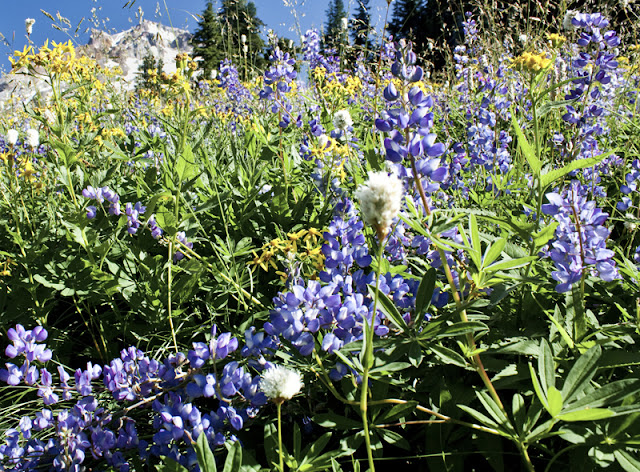A la niña winter. A warm, rain-ridden spring followed by late season snow
storms. A cool summer and a high alpine backpacking season frequently thwarted
by the lingering snowpack. Snowshoeing. New solo hikes. Blisters. Yellowstone. Spain. Bike wrecks & getting chased by geese. Although
recently I haven't been out as much as I would have liked (due to this little
thing called SKOOL), t'was a good year.
This is mostly just a trail summary, with some of my favorite pictures from last year.
JANUARY
Tamanawas Falls snowshoe, Mt. Hood Wilderness: ~4.5 miles, ~500 ft elevation change.
Boundary Trail, MSH National Monument: ~6 miles, ~1000 ft elevation change.
Coyote Wall, Columbia River Gorge: ~12 miles, ~1950 ft elevation change.
 |
| frozen Tamanawas Falls |
Boundary Trail, MSH National Monument: ~6 miles, ~1000 ft elevation change.
Coyote Wall, Columbia River Gorge: ~12 miles, ~1950 ft elevation change.
Eagle Creek, Columbia River Gorge: ~9 miles, ~600 ft elevation change.
FEBRUARY
We spent February 13th-18th in Yellowstone National Park. It's one of the best trips I have ever taken.
MARCH
Hummocks/Boundary Trail snowshoe, MSH National Monument: ~5.5 miles, ~1200 ft elevation change.
APRIL
 |
| Helens' winter coat |
APRIL
Swale Canyon, Klickitat Trail, Washington: ~6.5 miles, ~200 ft elevation change.
Multnomah-Franklin Ridge Loop, Columbia River Gorge: ~12 miles, ~2650 ft elevation change.
MAY
Hamilton Mountain, Columbia River Gorge: ~8 miles, ~2100 ft elevation change.
Ruckle Creek Trail, Columbia River Gorge: ~7 miles, ~2660 ft elevation change.
 |
| Hamilton & the Gorge |
Ruckle Creek Trail, Columbia River Gorge: ~7 miles, ~2660 ft elevation change.
JUNE
Swift Creek Trail, MSH National Monument: ~4.5 miles, ~1000 ft elevation change.
JULY
Burnt Lake Trail, Mt. Hood Wilderness: ~6.8 miles, ~1500 ft elevation change.
Grassy Knoll,Wind River Recreation Area: ~4.4 miles, ~1200 ft elevation change.
Mount Saint Helens Climb: 12 miles, 5600 ft elevation change.
Little Baldy, Silver Star Scenic Area: ~8.4 miles, ~1600 ft elevation change.
 |
| Worm Flows climbing route |
Little Baldy, Silver Star Scenic Area: ~8.4 miles, ~1600 ft elevation change.
Ed's Trail, Silver Star Scenic Area: ~5.5 miles, ~1400 ft elevation change.
AUGUST
Cooper Spur, Mt. Hood Wilderness: ~8 miles, ~2800 ft elevation change.
Goat Lake backpack, Goat Rocks Wilderness, Washington: 13 miles roundtrip, ~1770 ft elevation gain
Goat Lake backpack, Goat Rocks Wilderness, Washington: 13 miles roundtrip, ~1770 ft elevation gain
 |
| moonrise over Ives Peak & Old Snowy |
Wallace Falls State Park, Washington: 5.5 miles, 1200 ft elevation gain
SEPTEMBER
Santiam Pass-Canyon Creek Meadows-PCT Loop, Mt. Jefferson Wilderness: ~25 miles, no idea.
Zig Zag Canyon Overlook, Mt. Hood: ~5 miles, no idea.
Zig Zag Canyon Overlook, Mt. Hood: ~5 miles, no idea.
OCTOBER
Ingalls Lake backpack, Alpine Lakes Wilderness: ~10 miles, 2500 ft elevation change
Butte Camp Trail, MSH National Monument: ~8.5 miles, ~1700 ft elevation gain
Butte Camp Trail, MSH National Monument: ~8.5 miles, ~1700 ft elevation gain
NOVEMBER
(Nothing but project, project, paper, paper, exam, exam.)
DECEMBER
Coyote Canyon Trail, Columbia River Gorge: ~6ish miles? elevation gain unknown
Larch Mountain Trail, Columbia River Gorge: ~8 miles, ~2800 feet elevation gain
Larch Mountain Trail, Columbia River Gorge: ~8 miles, ~2800 feet elevation gain
~220.3 miles, ~40,400 feet elevation gain.










